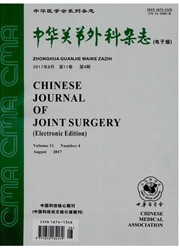

 中文摘要:
中文摘要:
目的:明确钛表面TiO2纳米管抗菌覆膜药物释放动力学特征,并通过体外试验测试其抗菌活性。方法电化学氧化法在钛金属表面构建TiO2纳米管表层,利用冻干法加载庆大霉素,在磷酸盐缓冲液中进行药物释放动力学研究。选择标准表皮葡萄球菌菌株,分别在负载和未负载药物纳米管及纯钛3种钛表面进行培养,通过观察细菌粘附和活性菌落存活情况进行表面抗菌活性对比研究。结果 NTS-G庆大霉素药物释放可分为两部分:初始突发释放和后期缓慢释放,初始释放浓度为51.50μg/mL,第6 h为73.13μg/ml,大多数负载的庆大霉素大约在9 h内释放。经过一个爆发性初始释放后,庆大霉素从纳米管释放呈现一个平台期,释放量几乎保持不变,维持在89.10μg/ml水平。3种钛表面体外抗菌活性检测发现,TiO2纳米管抗菌覆膜假体表面死亡细菌菌落显著增加(P<0.05)。结论钛表面TiO2纳米管抗菌覆膜为人工关节相关感染预防提供了新途径,骨科植入材料表面纳米管抗生素覆膜具有广泛的应用潜力。
 英文摘要:
英文摘要:
Objective To determine the release kinetics of gentamicin from the TiO2 nanotubes( TNS-G) , and to detect its an-tibacterial activity in vitro.Methods TiO2 nanotubes ( NTS) were fabricated on the titanium surface by electrochemical anodization. These nanotubes were loaded with gentamicin using a lyophilization method and vacuum drying, and its pharmacokinetics was detected in phosphate buffer.Staphylococcus aureus was used to study the antibacterial properties of the NTS-G.There were three study groups:the commercially pure titanium( Cp-Ti) group, the NTS group, and the NTS-G group.We compared the antibacterial efficacy with each other by bacterial adhesion and colony counting in bacterial culture.Results Drug release of NTS-G could be divided into two parts:initial burst release and relatively slow release.The fast initial concentration was 51.50 μg/ml , and 73.13 μg/ml at the 6 th hours. Most of load gentamicin was released within approximately 9 hours.In the second phase, different drug release kinetics were observed, with very slow and linearly increasing cumulative release over a period of 90 h.The drug concentration was maintained at about 89.10μg/ml.We found that NTS-G could significantly inhibit bacterial adhesion and bioflm formation, compared with Cp-Ti or NTS, ( P〈0.05).Conclusions Titanium dioxide nanotubes loaded with antibiotics can deliver a high concentration of antibiotics locally at a specifc site, thereby providing a new strategy to prevent implant-associated infections.
 同期刊论文项目
同期刊论文项目
 同项目期刊论文
同项目期刊论文
 Surface characteristics of Zinc–TiO2 coatingsprepared via micro-arc oxidation. Composite Interfaces,
Surface characteristics of Zinc–TiO2 coatingsprepared via micro-arc oxidation. Composite Interfaces, 期刊信息
期刊信息
